For the past five days or so we have been traveling and  transitioning north from Temuco. We’ve had long days of driving many kilometers, but we are now finally through Norte Chico, or Chile’s Little North, and into the true northern part of this latitudinally-vast country. Located south of the Atacama Desert, this region starts north of Santiago with numerous vineyards in the central valley’s Mediterranean-like climate. Although we have passed through the verdant Elqui Valley, most of the landscape has become increasingly brown and barren. Cacti and scrub occur sporadically, but the landscape is generally devoid of much color. (We are told that the desert does sometimes burst into bloom in the spring here, but we are observing little vegetation and no flowers now in the late fall.) It is hard to imagine that the pre-Columbian fishermen and farmers thrived here, but they successfully
transitioning north from Temuco. We’ve had long days of driving many kilometers, but we are now finally through Norte Chico, or Chile’s Little North, and into the true northern part of this latitudinally-vast country. Located south of the Atacama Desert, this region starts north of Santiago with numerous vineyards in the central valley’s Mediterranean-like climate. Although we have passed through the verdant Elqui Valley, most of the landscape has become increasingly brown and barren. Cacti and scrub occur sporadically, but the landscape is generally devoid of much color. (We are told that the desert does sometimes burst into bloom in the spring here, but we are observing little vegetation and no flowers now in the late fall.) It is hard to imagine that the pre-Columbian fishermen and farmers thrived here, but they successfully  raised crops in the fertile river valleys and even in the more harsh upland areas. Europeans who attempted to settle in the area were far less successful in surmounting the numerous challenges of this inhospitable area, although Pedro Valdivia did found La Serena, Chile’s second -oldest city, in 1541. An unsuccessful gold rush in the 18th century was followed by silver-mining in the 19th century. Copper-mining now reigns supreme, and continues to be an important component in the Chilean economy.
raised crops in the fertile river valleys and even in the more harsh upland areas. Europeans who attempted to settle in the area were far less successful in surmounting the numerous challenges of this inhospitable area, although Pedro Valdivia did found La Serena, Chile’s second -oldest city, in 1541. An unsuccessful gold rush in the 18th century was followed by silver-mining in the 19th century. Copper-mining now reigns supreme, and continues to be an important component in the Chilean economy.
A few days ago we decided to escape the gloomy, 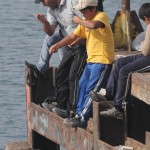 monotonous and often coastal haze-screened landscape of the Panamerican Highway and check out several towns on the Pacific coast. We stopped for a seafood lunch at the fishing port of Huasco, and spent part of the afternoon just hanging out on the pier on a peaceful Sunday. Families fished with minimal equipment (often just a long piece of fishing line wrapped around one’s hand, weighted with a small hook and a tiny bit of meat), and others just watched the serene scene. Many small and silvery fish resembling large anchovies were pulled up and stacked neatly beside the fisherpeople. We spent a long time watching a large group of pelicanos, and we took way too many pictures of these photogenic birds. All was simpatico until a local man arrived with a 20 liter bucket of fish market waste and dumped it
monotonous and often coastal haze-screened landscape of the Panamerican Highway and check out several towns on the Pacific coast. We stopped for a seafood lunch at the fishing port of Huasco, and spent part of the afternoon just hanging out on the pier on a peaceful Sunday. Families fished with minimal equipment (often just a long piece of fishing line wrapped around one’s hand, weighted with a small hook and a tiny bit of meat), and others just watched the serene scene. Many small and silvery fish resembling large anchovies were pulled up and stacked neatly beside the fisherpeople. We spent a long time watching a large group of pelicanos, and we took way too many pictures of these photogenic birds. All was simpatico until a local man arrived with a 20 liter bucket of fish market waste and dumped it  over the edge. Gone was the quiet atmosphere; a feeding frenzy occurred in which (surprisingly) no animals perished, given the number of very active participants: about 30 pelicans and 3 huge sea lions. Five minutes later, all was calm, except for a small group of birds vying for a starfish they’d dislodged from an algae-covered rock nearby. They squabbled over who might get the prize and as a result fumbled the food back to the sea. Cooperation seems to not be one of their skills…. Later on, we drove north to the picturesque seaside resort of Bahia Iglesa, named for the British privateers who sought refuge there in Colonial times. After saving our pesos at a charming and colorful Hostal El Punto in
over the edge. Gone was the quiet atmosphere; a feeding frenzy occurred in which (surprisingly) no animals perished, given the number of very active participants: about 30 pelicans and 3 huge sea lions. Five minutes later, all was calm, except for a small group of birds vying for a starfish they’d dislodged from an algae-covered rock nearby. They squabbled over who might get the prize and as a result fumbled the food back to the sea. Cooperation seems to not be one of their skills…. Later on, we drove north to the picturesque seaside resort of Bahia Iglesa, named for the British privateers who sought refuge there in Colonial times. After saving our pesos at a charming and colorful Hostal El Punto in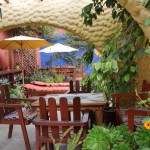 La Serena, we splurged further north in Bahia Iglesa and stayed at a modern, upscale hotel which was perched on a rocky cliff overlooking the bay with a lovely ocean view, complete with (green!) palm trees. As this is the off-season, we were nearly the only visitors in this five story behemoth..
La Serena, we splurged further north in Bahia Iglesa and stayed at a modern, upscale hotel which was perched on a rocky cliff overlooking the bay with a lovely ocean view, complete with (green!) palm trees. As this is the off-season, we were nearly the only visitors in this five story behemoth..
 Further north, the dull earth tones continued, with little life evident other than an occasional lizard. There were countless shrines along this road and they came in all shapes and sizes. We have seen no accidents on 2000km of the Panamerica. So,why so many shrines? Bizarre rock formations appeared out of nowhere, including, along one desolate stretch, a huge sculptured hand -made of granite, Mano del Desierto, jutting out of the desert’s crust. We read only that it
Further north, the dull earth tones continued, with little life evident other than an occasional lizard. There were countless shrines along this road and they came in all shapes and sizes. We have seen no accidents on 2000km of the Panamerica. So,why so many shrines? Bizarre rock formations appeared out of nowhere, including, along one desolate stretch, a huge sculptured hand -made of granite, Mano del Desierto, jutting out of the desert’s crust. We read only that it  was built in 1992 by sculptor Mario Irarrazaval, and the rest is a mystery. We decided to once again escape to the coast, and head off on a (reasonable, for a change…) dirt road to check out Parque Nacional Pan de Azucar. We stopped at the information center and talked to a friendly CONAF ranger and viewed our first Chilean cactarium, an outdoor exhibit of numerous cacti, most looking extremely dry, grey and…. dead. But we were assured that
was built in 1992 by sculptor Mario Irarrazaval, and the rest is a mystery. We decided to once again escape to the coast, and head off on a (reasonable, for a change…) dirt road to check out Parque Nacional Pan de Azucar. We stopped at the information center and talked to a friendly CONAF ranger and viewed our first Chilean cactarium, an outdoor exhibit of numerous cacti, most looking extremely dry, grey and…. dead. But we were assured that  this flora is indeed alive, and
this flora is indeed alive, and 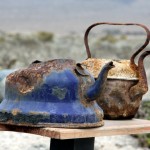 that it survives on the moisture from the frequent ocean fog known here known as camanchaca. The cactus and succulent display, complete with weathered tea kettles, added to the Salvador Dali feel of this unique visitor stop. The ranger said that it had rained twice in his experience there. And that is 33 years and counting. He said one rain storm was in 2005, the other in 2010, and he speculated on climate change!
that it survives on the moisture from the frequent ocean fog known here known as camanchaca. The cactus and succulent display, complete with weathered tea kettles, added to the Salvador Dali feel of this unique visitor stop. The ranger said that it had rained twice in his experience there. And that is 33 years and counting. He said one rain storm was in 2005, the other in 2010, and he speculated on climate change!
Leslie’s thirst for color was surprisingly satisfied in the coastal town of Taltal. Once with a population of 20,000 from the days of its past nitrate export business, it is now much smaller, but is supposedly currently growing a bit as copper miners begin to settle there. We found a modest hostal right on the oceanfront; its entryway was a glorious garden full of lovely hibiscus plants with happy splashes of color everywhere.
in the coastal town of Taltal. Once with a population of 20,000 from the days of its past nitrate export business, it is now much smaller, but is supposedly currently growing a bit as copper miners begin to settle there. We found a modest hostal right on the oceanfront; its entryway was a glorious garden full of lovely hibiscus plants with happy splashes of color everywhere.
As we head ed north toward our goal of San Pedro de 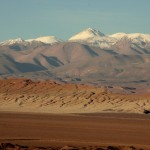 Atacama, there were hints that the landscape was finally changing. Land forms began to remind us of Georgia O’Keefe paintings with their more vibrant earth tones and rounded, sensual shapes, and there was
Atacama, there were hints that the landscape was finally changing. Land forms began to remind us of Georgia O’Keefe paintings with their more vibrant earth tones and rounded, sensual shapes, and there was 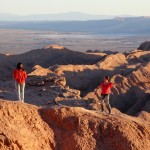 more variation in the geology. Numerous Andean snow-capped peaks emerged in the background as we finally saw the beginning of the Atacama Desert, close to the borders of Argentina and Bolivia.
more variation in the geology. Numerous Andean snow-capped peaks emerged in the background as we finally saw the beginning of the Atacama Desert, close to the borders of Argentina and Bolivia.
[shashin type=”album” id=”34″ size=”small” crop=”n” columns=”max” caption=”y” order=”date” position=”center”]
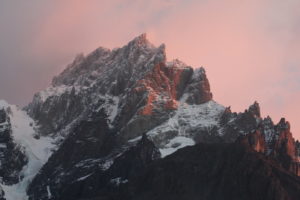
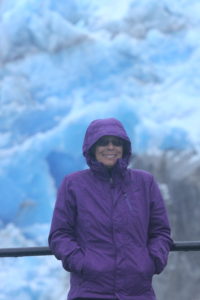
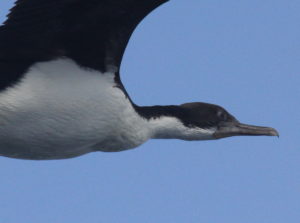
Nan
12 May 2012Hello Leslie and Val!
We continue to enjoy your blog! What an incredible experience you are having. What better way to understand a country…see every inch of it! I know it can be hard to get posts up while traveling and you are doing it. Thank you!
It is finally in the 70’s here, so it’s safe to come home. Sunny today! We are finally getting back into the pace of being home, but it took a month. Keep safe and keep enjoying!
Nan and Steve
Stormy
13 May 2012It’s so exciting for us to see you’re visiting San Pedro. Your photos of the endless brown were very familiar to Jessi when I showed her this morning. She says to be sure to see the snuff trays at the museum there. She worked with archaeologist Constantino Manuel Torres and his daughter Cristina Torres-Rouff at the museum in 2005. Constantino studies the hallucinogens the Tiwanaku used in their religious ceremonies and the elaborate trays they used.